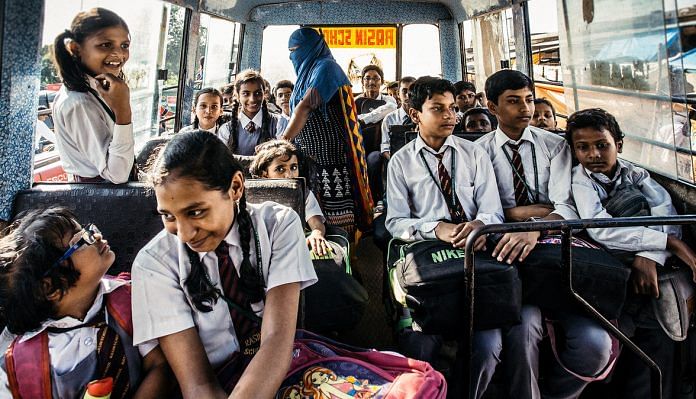Many Muslim kids have become targets of Islamophobia and nationalism in their classrooms and playgrounds and it’s a worrying trend.
The year was 2014 and as a new mother I felt the need to reach out to my counterparts. I was unprepared for what lay ahead. The stories that tumbled out of closets were unbelievable and often devastating. I spoke with 145 families across 12 cities over a span of a year for my research. They were a varied bunch but most of them told a single story — that they were worried and fearful for their children, many of whom were targets of Islamophobia and nationalism in their classrooms and playgrounds.
The large-scale incidence and the under-reporting of the subject worried me immensely. Of the hundred plus children I spoke to, 85 per cent of them told me that they had been bullied, hit or ostracised at school because of their religion. It seemed school bullying had a new target — the Muslim kid.
“My little one is only six-and-a-half years old and got hit for being a Muslim in school,” says Zareen Siddique, whose daughter Samaira studies in an internationally accredited school in Noida. A student sitting on the same bench as her asked, “Are you a Muslim?” He then started hitting Samaira, saying, “I hate Muslims.”
Zareen says it took a few days before her daughter could open up about it. I was appalled and shocked. I immediately called up the class teacher who had a two-word response, “It happens.”
However, the teacher did try to find a resolution and informed the parents of the child. But they said, “You are lying. My kid isn’t like that.”
Zareen says, “I have noticed these changes in the last few years. My elder kid has been in the same school for the past seven years but never faced anything like this. Only in the past two years do these incidents seem to be arising. But six- or seven-year-olds are just too young for such hate.”
The students I spoke to were mostly from expensive, upper-middle-class schools. If targeting Muslims was so rampant in the elite sections, I wondered what a similar survey in other social sections might throw up. I also saw patterns emerging from the interviews.
The incidence of religious bullying get reported much more at younger classes but are dismissed as stray or juvenile cases. In higher classes like grades 7–12 the attacks are more vicious, (like “You are a terrorist” or “Go to Pakistan”) but go largely under-reported. It often borders on violence among boys but is mostly in the form of subtle jokes among girls. For example, “Kya tumhare mamma papa bomb banate hain kya? (Do your parents make bombs at home?)” or “Don’t piss her off, she will bomb you!”
Most Muslim children, even when they have not faced any direct aggressive communal bullying, will definitely identify with such low-key but repetitive comments. Such jokes usually don’t ring alarm bells for parents. Many mothers dismissed such incidents as harmless banter that need not be given undue importance.
While physical violence is immediately recognised as damaging, verbal violence is seldom recognised for the harm it can cause as the implied meanings are internalised by our young. This is especially the case among girls, who are restrained by the social conditioning of silence from “giving it back” with violence.
I asked the mothers if the Muslim kids can retaliate in the same way — can a non-Muslim student be called a terrorist or Pakistani in “harmless jokes”? The answers were almost always a vehement “No”.
Most children and parents are embarrassed about it and believe it to be stray incidents. But the less they talk and report about it, the more it keeps happening. If we can’t handle discussing sex or sexual abuse, then how will we handle cases of misogyny, homophobia, casteism, and in the last decade or so, the rise of Islamophobia, which has certainly moved from our drawing rooms to the classrooms and school corridors?
Students who are victimised are rarely going to report the matter to teachers. The situation is complex and I sincerely hope all parents, educators and schools will take this as an eye-opener and individually and collectively think of measures to counter the hate that seems to be in the air. Otherwise we will be guilty of setting these young people on the path to becoming hate-filled adults as hate swallows both — the tormentor and the tormented.
Nazia Erum is author of the recently published book, ‘Mothering A Muslim’ by Juggernaut Books.




On Hindu names, everybody spreading hatred to split India by writing or presenting India wrongly or Hindus especially … Sadly this story website also doing same
what a nonsense these biased newspapers like The Quint, The Print, NDTV are all on agenda, now look how they try to create a propaganda against AADHAR to protect illegal migrant bangladeshi and rohingya, I lost my trust in media.
Seems like a propaganda piece against Hindus.
fully fabricated story. Print need to verify before letting it published on its platform.
What is your comment based on exactly? I suggest the print should delete comments that disparage journalism without bothering to give any reason at all!
What is your comment based on exactly? I suggest the print should delete comments that disparage journalism without bothering to give any reason at all!
Fully fabricated comment. Both IQ and EQ needs to be verified before letting interact on any social medium.